Coffee Shop: Regulatory, Political, and Economic Impact Analysis Essay
VerifiedAdded on 2023/04/11
|11
|1765
|351
Essay
AI Summary
This essay provides a comprehensive analysis of the regulatory and economic factors influencing the establishment and operation of a coffee shop in Australia. It begins with an abstract describing the coffee shop, Johns&Johns, and its offerings. The essay then delves into the legal requirements, including the Food Act 2006, food safety regulations, the Food Production Act, and the Australia New Zealand Food Standards Code, highlighting their relevance to food safety and business licensing. The essay also explores planning and construction regulations, emphasizing the importance of location and safety. Key economic concepts such as price elasticity of demand, income elasticity, and the dynamics of demand and supply are analyzed in the context of the coffee shop. The impact of trade, particularly with countries like Brazil, on the Australian coffee market is also examined, along with market segmentation based on coffee types, product types, flavor, and processing methods. The essay concludes by referencing relevant sources to support the analysis.
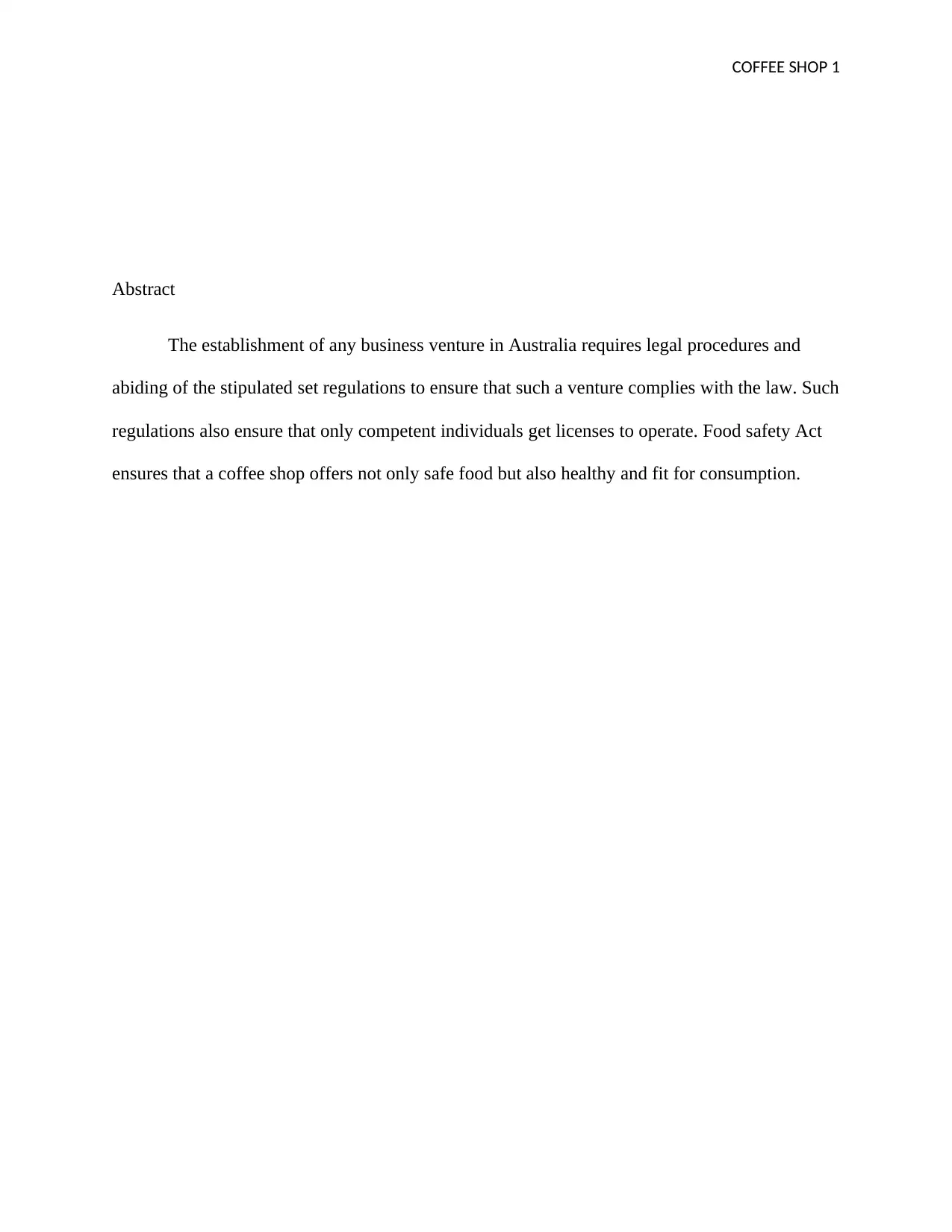
COFFEE SHOP 1
Abstract
The establishment of any business venture in Australia requires legal procedures and
abiding of the stipulated set regulations to ensure that such a venture complies with the law. Such
regulations also ensure that only competent individuals get licenses to operate. Food safety Act
ensures that a coffee shop offers not only safe food but also healthy and fit for consumption.
Abstract
The establishment of any business venture in Australia requires legal procedures and
abiding of the stipulated set regulations to ensure that such a venture complies with the law. Such
regulations also ensure that only competent individuals get licenses to operate. Food safety Act
ensures that a coffee shop offers not only safe food but also healthy and fit for consumption.
Paraphrase This Document
Need a fresh take? Get an instant paraphrase of this document with our AI Paraphraser
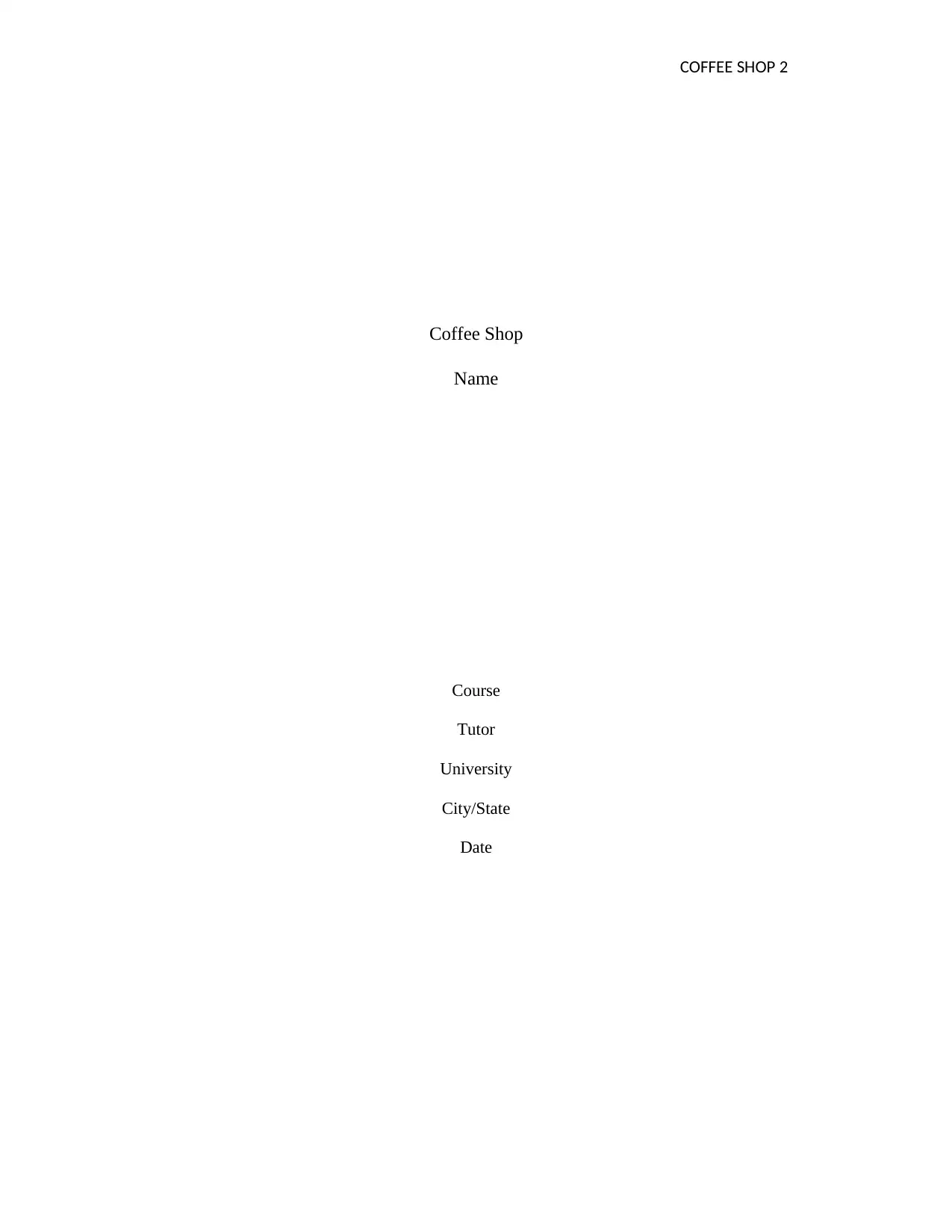
COFFEE SHOP 2
Coffee Shop
Name
Course
Tutor
University
City/State
Date
Coffee Shop
Name
Course
Tutor
University
City/State
Date
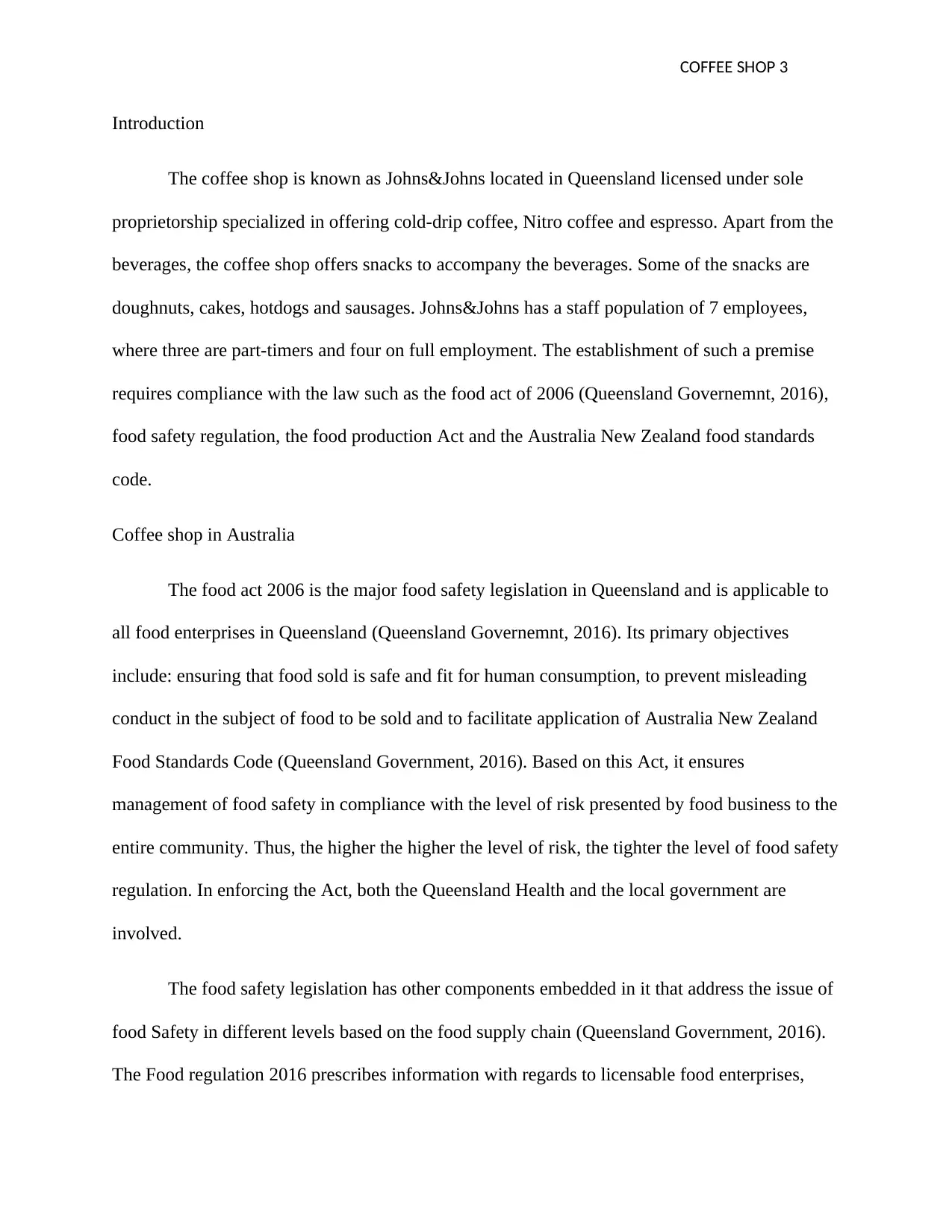
COFFEE SHOP 3
Introduction
The coffee shop is known as Johns&Johns located in Queensland licensed under sole
proprietorship specialized in offering cold-drip coffee, Nitro coffee and espresso. Apart from the
beverages, the coffee shop offers snacks to accompany the beverages. Some of the snacks are
doughnuts, cakes, hotdogs and sausages. Johns&Johns has a staff population of 7 employees,
where three are part-timers and four on full employment. The establishment of such a premise
requires compliance with the law such as the food act of 2006 (Queensland Governemnt, 2016),
food safety regulation, the food production Act and the Australia New Zealand food standards
code.
Coffee shop in Australia
The food act 2006 is the major food safety legislation in Queensland and is applicable to
all food enterprises in Queensland (Queensland Governemnt, 2016). Its primary objectives
include: ensuring that food sold is safe and fit for human consumption, to prevent misleading
conduct in the subject of food to be sold and to facilitate application of Australia New Zealand
Food Standards Code (Queensland Government, 2016). Based on this Act, it ensures
management of food safety in compliance with the level of risk presented by food business to the
entire community. Thus, the higher the higher the level of risk, the tighter the level of food safety
regulation. In enforcing the Act, both the Queensland Health and the local government are
involved.
The food safety legislation has other components embedded in it that address the issue of
food Safety in different levels based on the food supply chain (Queensland Government, 2016).
The Food regulation 2016 prescribes information with regards to licensable food enterprises,
Introduction
The coffee shop is known as Johns&Johns located in Queensland licensed under sole
proprietorship specialized in offering cold-drip coffee, Nitro coffee and espresso. Apart from the
beverages, the coffee shop offers snacks to accompany the beverages. Some of the snacks are
doughnuts, cakes, hotdogs and sausages. Johns&Johns has a staff population of 7 employees,
where three are part-timers and four on full employment. The establishment of such a premise
requires compliance with the law such as the food act of 2006 (Queensland Governemnt, 2016),
food safety regulation, the food production Act and the Australia New Zealand food standards
code.
Coffee shop in Australia
The food act 2006 is the major food safety legislation in Queensland and is applicable to
all food enterprises in Queensland (Queensland Governemnt, 2016). Its primary objectives
include: ensuring that food sold is safe and fit for human consumption, to prevent misleading
conduct in the subject of food to be sold and to facilitate application of Australia New Zealand
Food Standards Code (Queensland Government, 2016). Based on this Act, it ensures
management of food safety in compliance with the level of risk presented by food business to the
entire community. Thus, the higher the higher the level of risk, the tighter the level of food safety
regulation. In enforcing the Act, both the Queensland Health and the local government are
involved.
The food safety legislation has other components embedded in it that address the issue of
food Safety in different levels based on the food supply chain (Queensland Government, 2016).
The Food regulation 2016 prescribes information with regards to licensable food enterprises,
⊘ This is a preview!⊘
Do you want full access?
Subscribe today to unlock all pages.

Trusted by 1+ million students worldwide
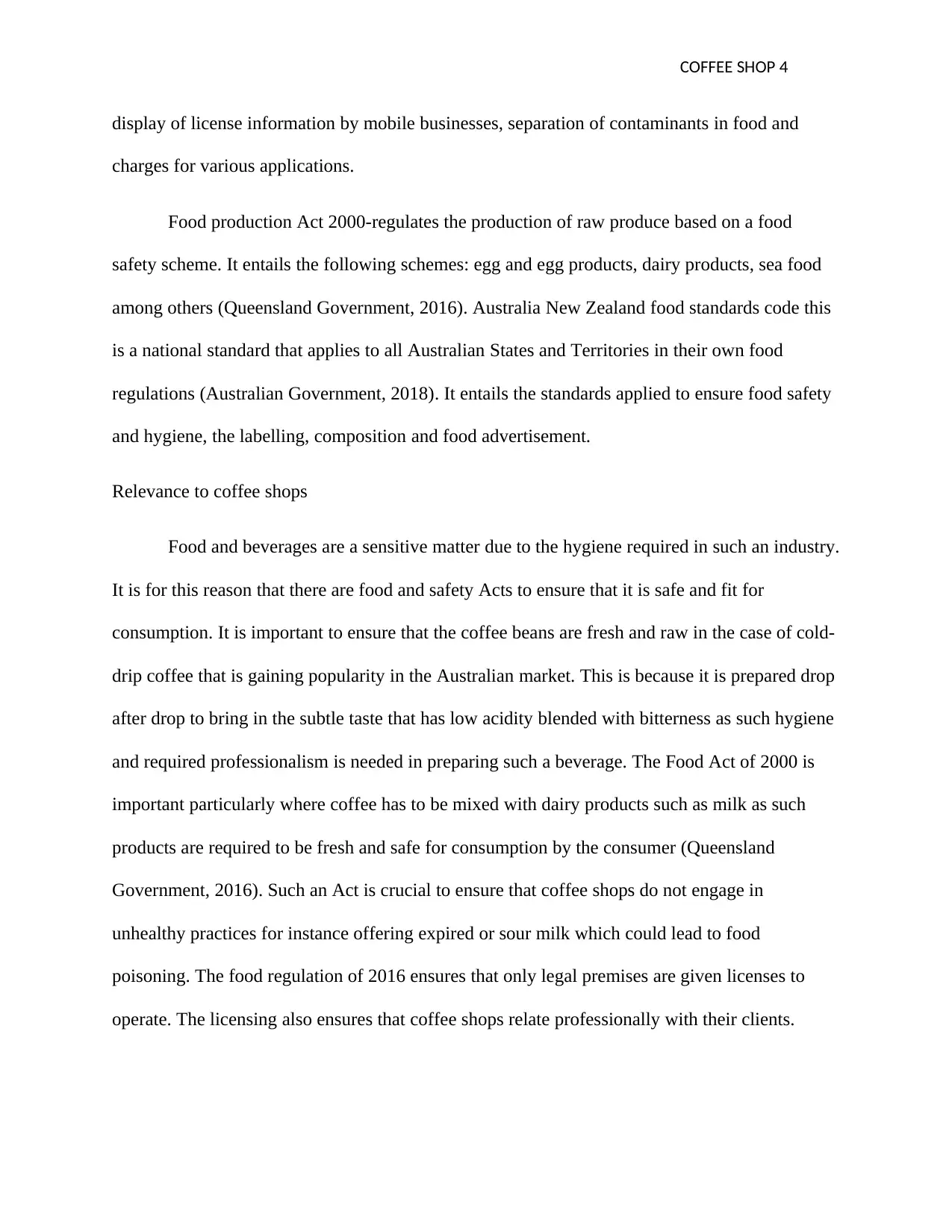
COFFEE SHOP 4
display of license information by mobile businesses, separation of contaminants in food and
charges for various applications.
Food production Act 2000-regulates the production of raw produce based on a food
safety scheme. It entails the following schemes: egg and egg products, dairy products, sea food
among others (Queensland Government, 2016). Australia New Zealand food standards code this
is a national standard that applies to all Australian States and Territories in their own food
regulations (Australian Government, 2018). It entails the standards applied to ensure food safety
and hygiene, the labelling, composition and food advertisement.
Relevance to coffee shops
Food and beverages are a sensitive matter due to the hygiene required in such an industry.
It is for this reason that there are food and safety Acts to ensure that it is safe and fit for
consumption. It is important to ensure that the coffee beans are fresh and raw in the case of cold-
drip coffee that is gaining popularity in the Australian market. This is because it is prepared drop
after drop to bring in the subtle taste that has low acidity blended with bitterness as such hygiene
and required professionalism is needed in preparing such a beverage. The Food Act of 2000 is
important particularly where coffee has to be mixed with dairy products such as milk as such
products are required to be fresh and safe for consumption by the consumer (Queensland
Government, 2016). Such an Act is crucial to ensure that coffee shops do not engage in
unhealthy practices for instance offering expired or sour milk which could lead to food
poisoning. The food regulation of 2016 ensures that only legal premises are given licenses to
operate. The licensing also ensures that coffee shops relate professionally with their clients.
display of license information by mobile businesses, separation of contaminants in food and
charges for various applications.
Food production Act 2000-regulates the production of raw produce based on a food
safety scheme. It entails the following schemes: egg and egg products, dairy products, sea food
among others (Queensland Government, 2016). Australia New Zealand food standards code this
is a national standard that applies to all Australian States and Territories in their own food
regulations (Australian Government, 2018). It entails the standards applied to ensure food safety
and hygiene, the labelling, composition and food advertisement.
Relevance to coffee shops
Food and beverages are a sensitive matter due to the hygiene required in such an industry.
It is for this reason that there are food and safety Acts to ensure that it is safe and fit for
consumption. It is important to ensure that the coffee beans are fresh and raw in the case of cold-
drip coffee that is gaining popularity in the Australian market. This is because it is prepared drop
after drop to bring in the subtle taste that has low acidity blended with bitterness as such hygiene
and required professionalism is needed in preparing such a beverage. The Food Act of 2000 is
important particularly where coffee has to be mixed with dairy products such as milk as such
products are required to be fresh and safe for consumption by the consumer (Queensland
Government, 2016). Such an Act is crucial to ensure that coffee shops do not engage in
unhealthy practices for instance offering expired or sour milk which could lead to food
poisoning. The food regulation of 2016 ensures that only legal premises are given licenses to
operate. The licensing also ensures that coffee shops relate professionally with their clients.
Paraphrase This Document
Need a fresh take? Get an instant paraphrase of this document with our AI Paraphraser
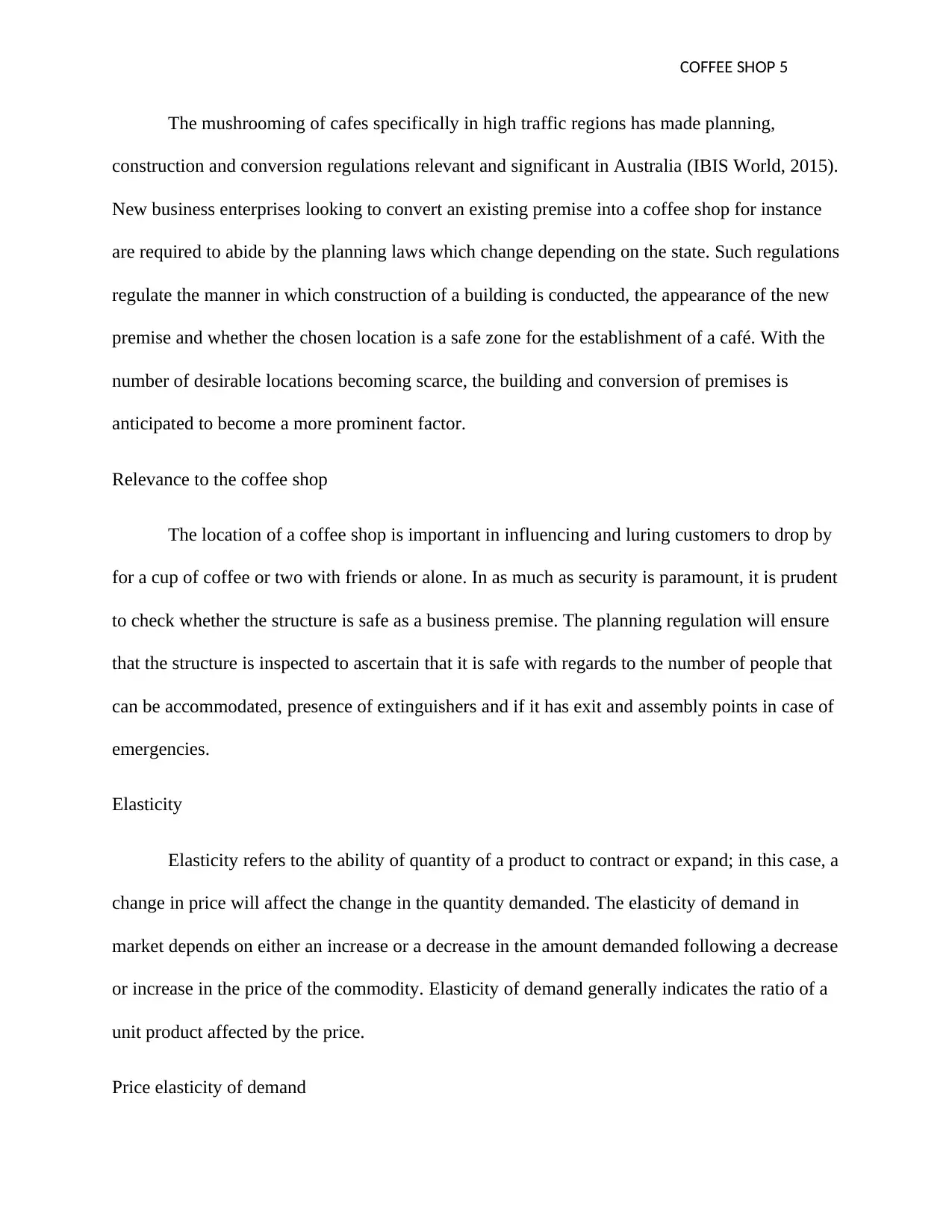
COFFEE SHOP 5
The mushrooming of cafes specifically in high traffic regions has made planning,
construction and conversion regulations relevant and significant in Australia (IBIS World, 2015).
New business enterprises looking to convert an existing premise into a coffee shop for instance
are required to abide by the planning laws which change depending on the state. Such regulations
regulate the manner in which construction of a building is conducted, the appearance of the new
premise and whether the chosen location is a safe zone for the establishment of a café. With the
number of desirable locations becoming scarce, the building and conversion of premises is
anticipated to become a more prominent factor.
Relevance to the coffee shop
The location of a coffee shop is important in influencing and luring customers to drop by
for a cup of coffee or two with friends or alone. In as much as security is paramount, it is prudent
to check whether the structure is safe as a business premise. The planning regulation will ensure
that the structure is inspected to ascertain that it is safe with regards to the number of people that
can be accommodated, presence of extinguishers and if it has exit and assembly points in case of
emergencies.
Elasticity
Elasticity refers to the ability of quantity of a product to contract or expand; in this case, a
change in price will affect the change in the quantity demanded. The elasticity of demand in
market depends on either an increase or a decrease in the amount demanded following a decrease
or increase in the price of the commodity. Elasticity of demand generally indicates the ratio of a
unit product affected by the price.
Price elasticity of demand
The mushrooming of cafes specifically in high traffic regions has made planning,
construction and conversion regulations relevant and significant in Australia (IBIS World, 2015).
New business enterprises looking to convert an existing premise into a coffee shop for instance
are required to abide by the planning laws which change depending on the state. Such regulations
regulate the manner in which construction of a building is conducted, the appearance of the new
premise and whether the chosen location is a safe zone for the establishment of a café. With the
number of desirable locations becoming scarce, the building and conversion of premises is
anticipated to become a more prominent factor.
Relevance to the coffee shop
The location of a coffee shop is important in influencing and luring customers to drop by
for a cup of coffee or two with friends or alone. In as much as security is paramount, it is prudent
to check whether the structure is safe as a business premise. The planning regulation will ensure
that the structure is inspected to ascertain that it is safe with regards to the number of people that
can be accommodated, presence of extinguishers and if it has exit and assembly points in case of
emergencies.
Elasticity
Elasticity refers to the ability of quantity of a product to contract or expand; in this case, a
change in price will affect the change in the quantity demanded. The elasticity of demand in
market depends on either an increase or a decrease in the amount demanded following a decrease
or increase in the price of the commodity. Elasticity of demand generally indicates the ratio of a
unit product affected by the price.
Price elasticity of demand
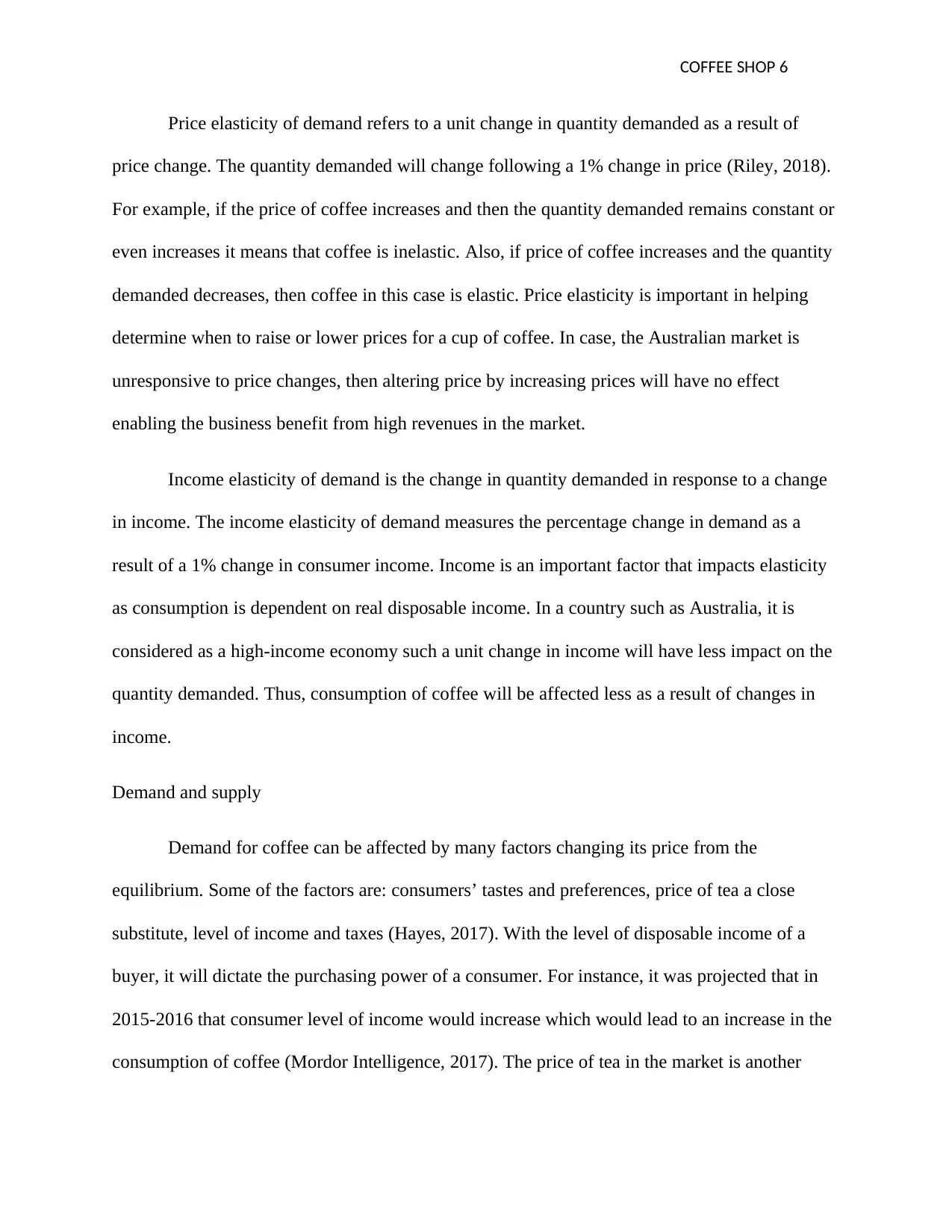
COFFEE SHOP 6
Price elasticity of demand refers to a unit change in quantity demanded as a result of
price change. The quantity demanded will change following a 1% change in price (Riley, 2018).
For example, if the price of coffee increases and then the quantity demanded remains constant or
even increases it means that coffee is inelastic. Also, if price of coffee increases and the quantity
demanded decreases, then coffee in this case is elastic. Price elasticity is important in helping
determine when to raise or lower prices for a cup of coffee. In case, the Australian market is
unresponsive to price changes, then altering price by increasing prices will have no effect
enabling the business benefit from high revenues in the market.
Income elasticity of demand is the change in quantity demanded in response to a change
in income. The income elasticity of demand measures the percentage change in demand as a
result of a 1% change in consumer income. Income is an important factor that impacts elasticity
as consumption is dependent on real disposable income. In a country such as Australia, it is
considered as a high-income economy such a unit change in income will have less impact on the
quantity demanded. Thus, consumption of coffee will be affected less as a result of changes in
income.
Demand and supply
Demand for coffee can be affected by many factors changing its price from the
equilibrium. Some of the factors are: consumers’ tastes and preferences, price of tea a close
substitute, level of income and taxes (Hayes, 2017). With the level of disposable income of a
buyer, it will dictate the purchasing power of a consumer. For instance, it was projected that in
2015-2016 that consumer level of income would increase which would lead to an increase in the
consumption of coffee (Mordor Intelligence, 2017). The price of tea in the market is another
Price elasticity of demand refers to a unit change in quantity demanded as a result of
price change. The quantity demanded will change following a 1% change in price (Riley, 2018).
For example, if the price of coffee increases and then the quantity demanded remains constant or
even increases it means that coffee is inelastic. Also, if price of coffee increases and the quantity
demanded decreases, then coffee in this case is elastic. Price elasticity is important in helping
determine when to raise or lower prices for a cup of coffee. In case, the Australian market is
unresponsive to price changes, then altering price by increasing prices will have no effect
enabling the business benefit from high revenues in the market.
Income elasticity of demand is the change in quantity demanded in response to a change
in income. The income elasticity of demand measures the percentage change in demand as a
result of a 1% change in consumer income. Income is an important factor that impacts elasticity
as consumption is dependent on real disposable income. In a country such as Australia, it is
considered as a high-income economy such a unit change in income will have less impact on the
quantity demanded. Thus, consumption of coffee will be affected less as a result of changes in
income.
Demand and supply
Demand for coffee can be affected by many factors changing its price from the
equilibrium. Some of the factors are: consumers’ tastes and preferences, price of tea a close
substitute, level of income and taxes (Hayes, 2017). With the level of disposable income of a
buyer, it will dictate the purchasing power of a consumer. For instance, it was projected that in
2015-2016 that consumer level of income would increase which would lead to an increase in the
consumption of coffee (Mordor Intelligence, 2017). The price of tea in the market is another
⊘ This is a preview!⊘
Do you want full access?
Subscribe today to unlock all pages.

Trusted by 1+ million students worldwide
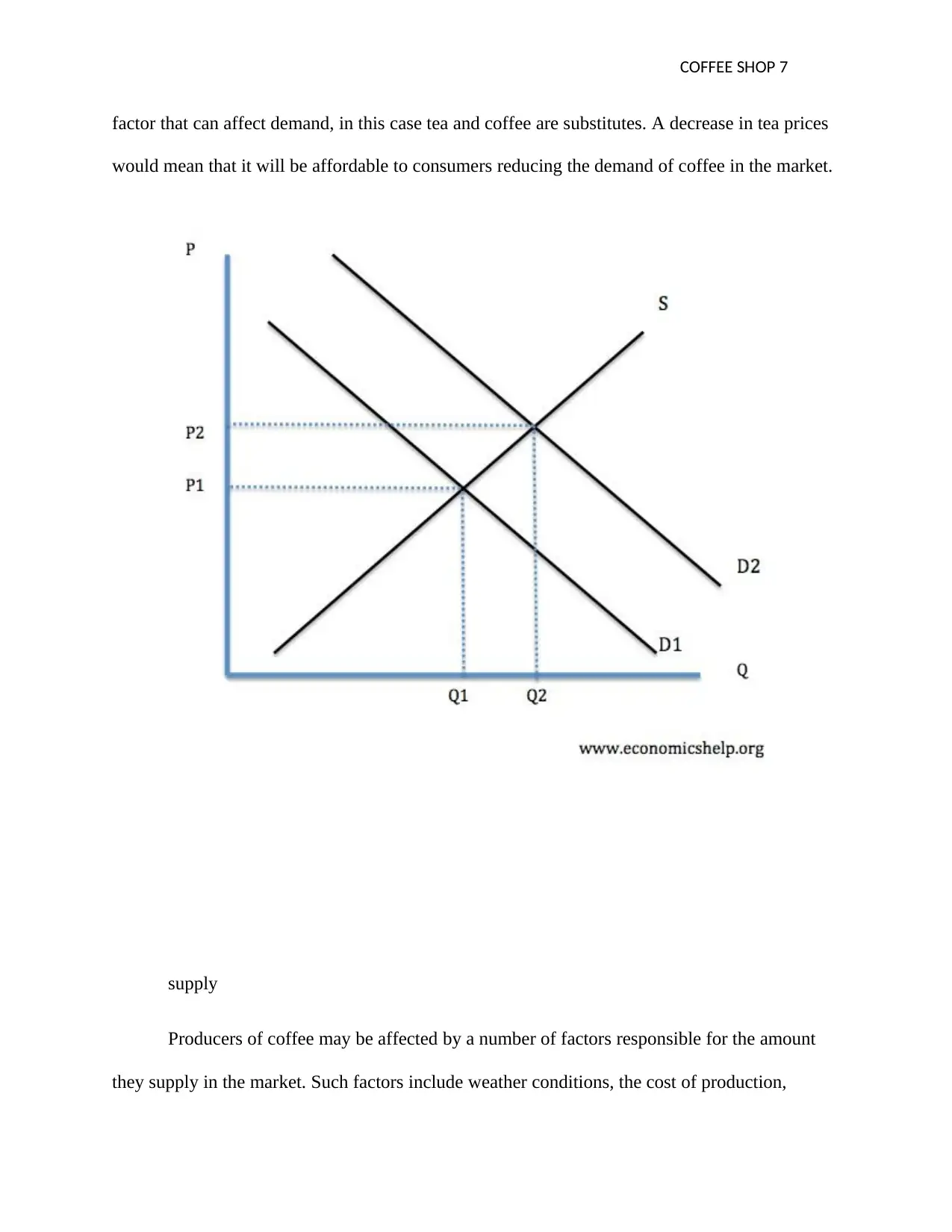
COFFEE SHOP 7
factor that can affect demand, in this case tea and coffee are substitutes. A decrease in tea prices
would mean that it will be affordable to consumers reducing the demand of coffee in the market.
supply
Producers of coffee may be affected by a number of factors responsible for the amount
they supply in the market. Such factors include weather conditions, the cost of production,
factor that can affect demand, in this case tea and coffee are substitutes. A decrease in tea prices
would mean that it will be affordable to consumers reducing the demand of coffee in the market.
supply
Producers of coffee may be affected by a number of factors responsible for the amount
they supply in the market. Such factors include weather conditions, the cost of production,
Paraphrase This Document
Need a fresh take? Get an instant paraphrase of this document with our AI Paraphraser
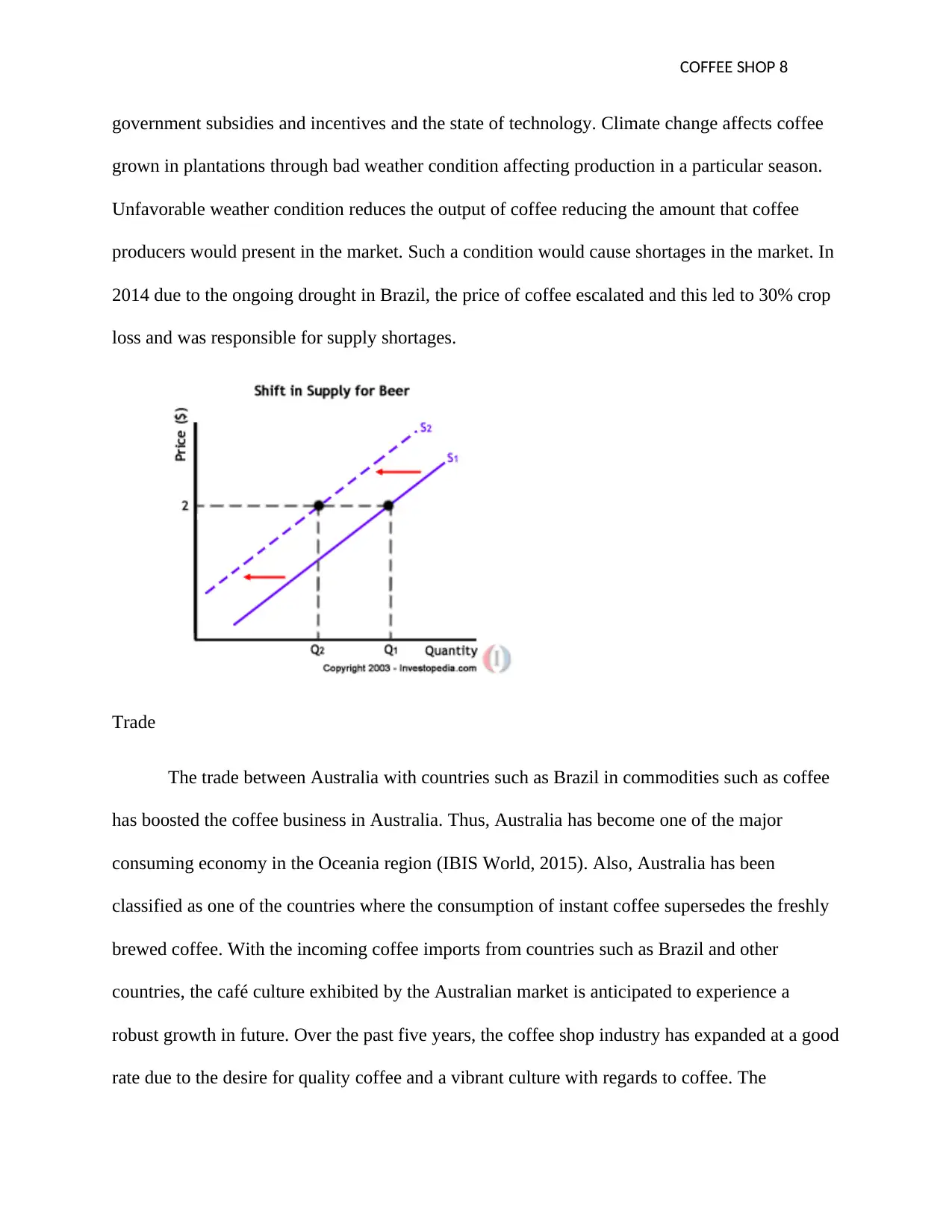
COFFEE SHOP 8
government subsidies and incentives and the state of technology. Climate change affects coffee
grown in plantations through bad weather condition affecting production in a particular season.
Unfavorable weather condition reduces the output of coffee reducing the amount that coffee
producers would present in the market. Such a condition would cause shortages in the market. In
2014 due to the ongoing drought in Brazil, the price of coffee escalated and this led to 30% crop
loss and was responsible for supply shortages.
Trade
The trade between Australia with countries such as Brazil in commodities such as coffee
has boosted the coffee business in Australia. Thus, Australia has become one of the major
consuming economy in the Oceania region (IBIS World, 2015). Also, Australia has been
classified as one of the countries where the consumption of instant coffee supersedes the freshly
brewed coffee. With the incoming coffee imports from countries such as Brazil and other
countries, the café culture exhibited by the Australian market is anticipated to experience a
robust growth in future. Over the past five years, the coffee shop industry has expanded at a good
rate due to the desire for quality coffee and a vibrant culture with regards to coffee. The
government subsidies and incentives and the state of technology. Climate change affects coffee
grown in plantations through bad weather condition affecting production in a particular season.
Unfavorable weather condition reduces the output of coffee reducing the amount that coffee
producers would present in the market. Such a condition would cause shortages in the market. In
2014 due to the ongoing drought in Brazil, the price of coffee escalated and this led to 30% crop
loss and was responsible for supply shortages.
Trade
The trade between Australia with countries such as Brazil in commodities such as coffee
has boosted the coffee business in Australia. Thus, Australia has become one of the major
consuming economy in the Oceania region (IBIS World, 2015). Also, Australia has been
classified as one of the countries where the consumption of instant coffee supersedes the freshly
brewed coffee. With the incoming coffee imports from countries such as Brazil and other
countries, the café culture exhibited by the Australian market is anticipated to experience a
robust growth in future. Over the past five years, the coffee shop industry has expanded at a good
rate due to the desire for quality coffee and a vibrant culture with regards to coffee. The
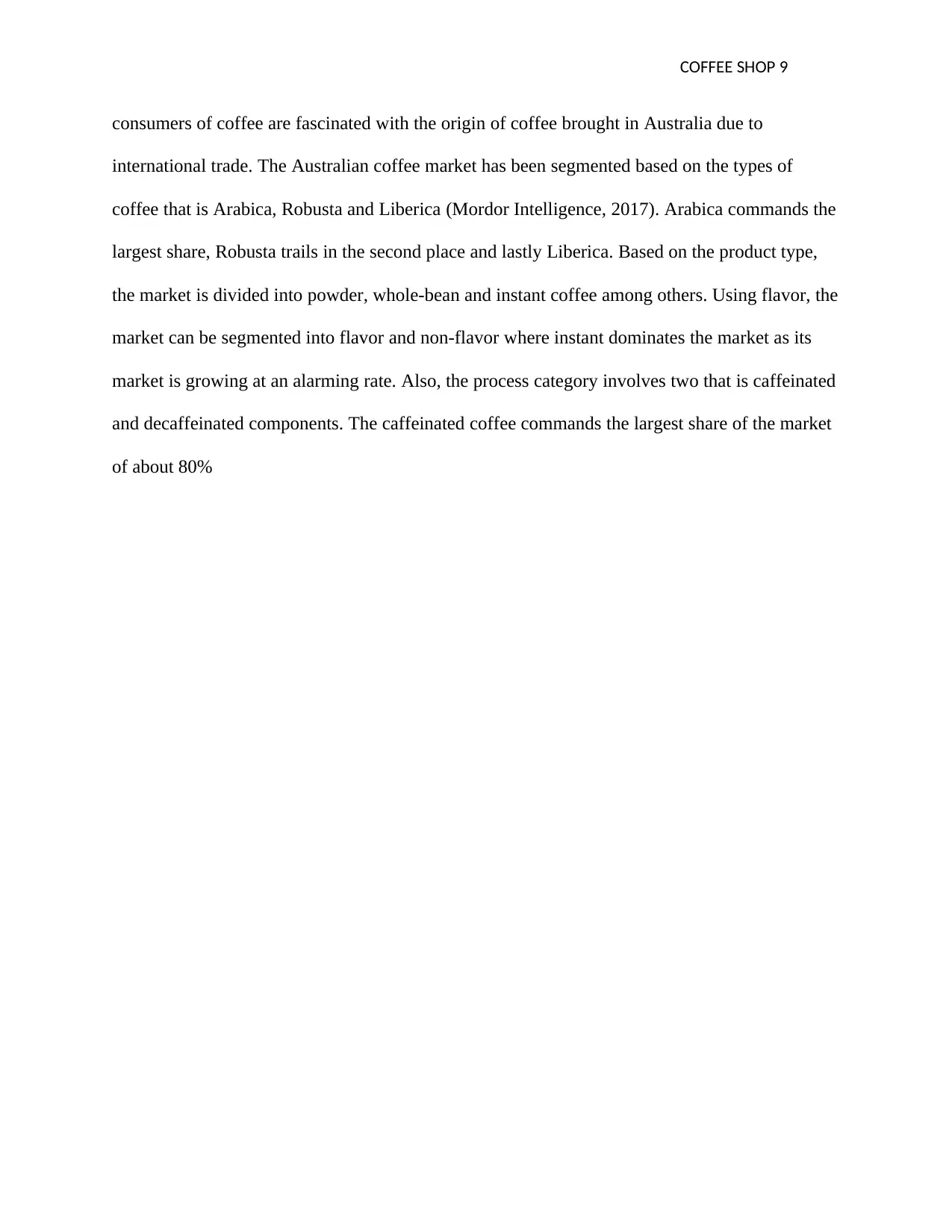
COFFEE SHOP 9
consumers of coffee are fascinated with the origin of coffee brought in Australia due to
international trade. The Australian coffee market has been segmented based on the types of
coffee that is Arabica, Robusta and Liberica (Mordor Intelligence, 2017). Arabica commands the
largest share, Robusta trails in the second place and lastly Liberica. Based on the product type,
the market is divided into powder, whole-bean and instant coffee among others. Using flavor, the
market can be segmented into flavor and non-flavor where instant dominates the market as its
market is growing at an alarming rate. Also, the process category involves two that is caffeinated
and decaffeinated components. The caffeinated coffee commands the largest share of the market
of about 80%
consumers of coffee are fascinated with the origin of coffee brought in Australia due to
international trade. The Australian coffee market has been segmented based on the types of
coffee that is Arabica, Robusta and Liberica (Mordor Intelligence, 2017). Arabica commands the
largest share, Robusta trails in the second place and lastly Liberica. Based on the product type,
the market is divided into powder, whole-bean and instant coffee among others. Using flavor, the
market can be segmented into flavor and non-flavor where instant dominates the market as its
market is growing at an alarming rate. Also, the process category involves two that is caffeinated
and decaffeinated components. The caffeinated coffee commands the largest share of the market
of about 80%
⊘ This is a preview!⊘
Do you want full access?
Subscribe today to unlock all pages.

Trusted by 1+ million students worldwide
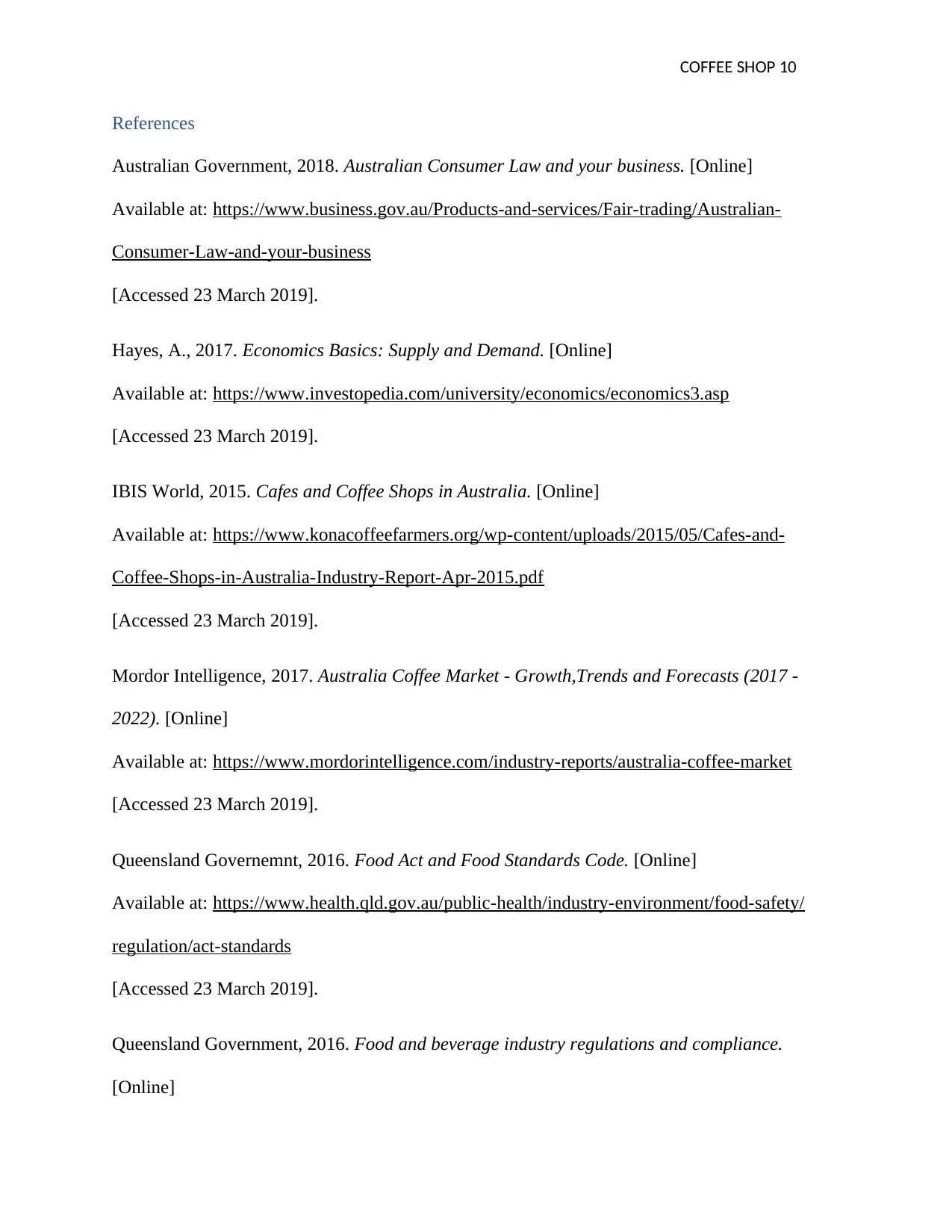
COFFEE SHOP 10
References
Australian Government, 2018. Australian Consumer Law and your business. [Online]
Available at: https://www.business.gov.au/Products-and-services/Fair-trading/Australian-
Consumer-Law-and-your-business
[Accessed 23 March 2019].
Hayes, A., 2017. Economics Basics: Supply and Demand. [Online]
Available at: https://www.investopedia.com/university/economics/economics3.asp
[Accessed 23 March 2019].
IBIS World, 2015. Cafes and Coffee Shops in Australia. [Online]
Available at: https://www.konacoffeefarmers.org/wp-content/uploads/2015/05/Cafes-and-
Coffee-Shops-in-Australia-Industry-Report-Apr-2015.pdf
[Accessed 23 March 2019].
Mordor Intelligence, 2017. Australia Coffee Market - Growth,Trends and Forecasts (2017 -
2022). [Online]
Available at: https://www.mordorintelligence.com/industry-reports/australia-coffee-market
[Accessed 23 March 2019].
Queensland Governemnt, 2016. Food Act and Food Standards Code. [Online]
Available at: https://www.health.qld.gov.au/public-health/industry-environment/food-safety/
regulation/act-standards
[Accessed 23 March 2019].
Queensland Government, 2016. Food and beverage industry regulations and compliance.
[Online]
References
Australian Government, 2018. Australian Consumer Law and your business. [Online]
Available at: https://www.business.gov.au/Products-and-services/Fair-trading/Australian-
Consumer-Law-and-your-business
[Accessed 23 March 2019].
Hayes, A., 2017. Economics Basics: Supply and Demand. [Online]
Available at: https://www.investopedia.com/university/economics/economics3.asp
[Accessed 23 March 2019].
IBIS World, 2015. Cafes and Coffee Shops in Australia. [Online]
Available at: https://www.konacoffeefarmers.org/wp-content/uploads/2015/05/Cafes-and-
Coffee-Shops-in-Australia-Industry-Report-Apr-2015.pdf
[Accessed 23 March 2019].
Mordor Intelligence, 2017. Australia Coffee Market - Growth,Trends and Forecasts (2017 -
2022). [Online]
Available at: https://www.mordorintelligence.com/industry-reports/australia-coffee-market
[Accessed 23 March 2019].
Queensland Governemnt, 2016. Food Act and Food Standards Code. [Online]
Available at: https://www.health.qld.gov.au/public-health/industry-environment/food-safety/
regulation/act-standards
[Accessed 23 March 2019].
Queensland Government, 2016. Food and beverage industry regulations and compliance.
[Online]
Paraphrase This Document
Need a fresh take? Get an instant paraphrase of this document with our AI Paraphraser
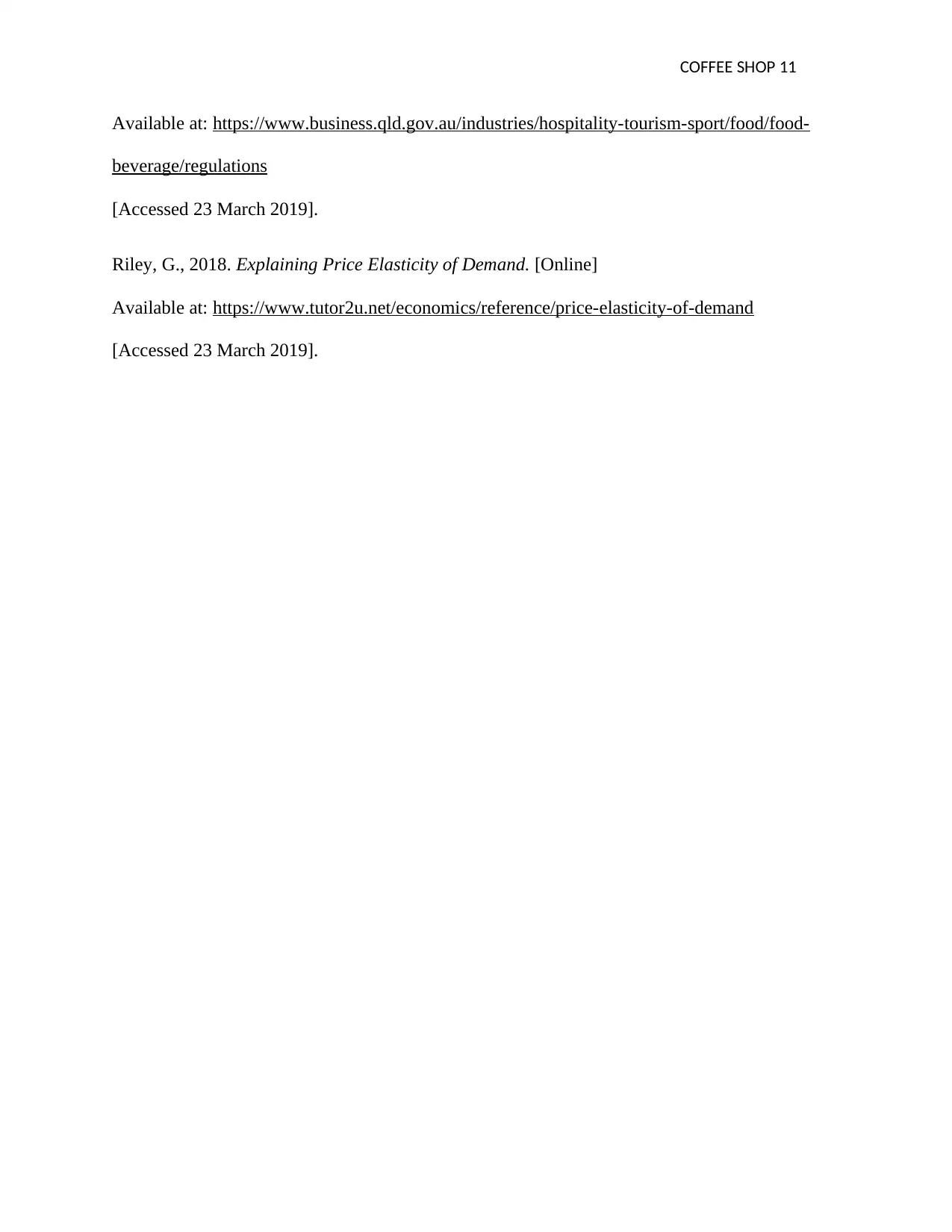
COFFEE SHOP 11
Available at: https://www.business.qld.gov.au/industries/hospitality-tourism-sport/food/food-
beverage/regulations
[Accessed 23 March 2019].
Riley, G., 2018. Explaining Price Elasticity of Demand. [Online]
Available at: https://www.tutor2u.net/economics/reference/price-elasticity-of-demand
[Accessed 23 March 2019].
Available at: https://www.business.qld.gov.au/industries/hospitality-tourism-sport/food/food-
beverage/regulations
[Accessed 23 March 2019].
Riley, G., 2018. Explaining Price Elasticity of Demand. [Online]
Available at: https://www.tutor2u.net/economics/reference/price-elasticity-of-demand
[Accessed 23 March 2019].
1 out of 11
Related Documents
Your All-in-One AI-Powered Toolkit for Academic Success.
+13062052269
info@desklib.com
Available 24*7 on WhatsApp / Email
![[object Object]](/_next/static/media/star-bottom.7253800d.svg)
Unlock your academic potential
Copyright © 2020–2025 A2Z Services. All Rights Reserved. Developed and managed by ZUCOL.





